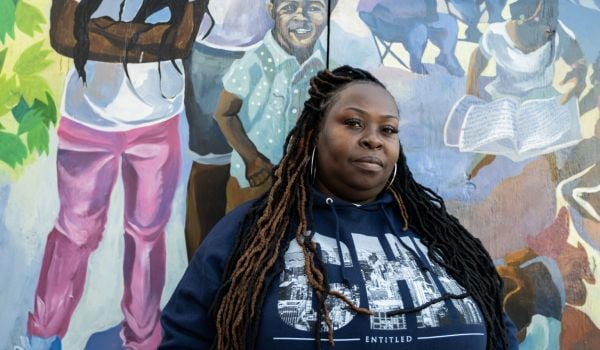As I mentioned in my feature on crime in Washington, D.C., the “Broken Windows” theory – that signs of social disorder foster a sense of lawlessness and lead to crimes, even violent crimes – has become widely accepted by policymakers across the political spectrum. Even people who would not consider themselves Broken Windows advocates, or law-and-order types more generally, support policies that operate from the same premise, such as anti-loitering laws and the jailing of minor miscreants, such as graffiti writers and pot smokers.
I am just old enough to remember the time when jumping a subway turn style or catching a tag would get you a warning, not even a ticket, in New York City. The Giuliani era, with the Mayor’s ardent belief in Broken Windows (remember the squeegee men?) changed all of that, and crime fell dramatically. But was it the enforcement of so-called “quality of life crimes,” that led the murder rate to fall? Or was it some immeasurable combination of longer prison sentences keeping criminals off the street, demographic shifts led by the legalization of abortion, the waning of the crack epidemic, and other police tactics such as the implementation of the Comp Stat crime tracking system?
Increasingly, criminologists are challenging Broken Windows’ hegemonic grasp on urban public policy. My travels in Europe have convinced me, once a Broken Windows believer, that it is largely a lot of hokum. Let the pot dealers return to Washington Square Park, the graffiti sit indefinitely on the mailboxes, the hookers wander Times Square, and I’m not at all sure you’d see an increase in violent crime as a result.
Berlin, Germany, a city of 3.4 million, is rife with symbols of social disorder. Sitting at a bar’s outdoor table you’re liable to smell hash wafting over from the table next to you, and to be offered it while walking through some of the city’s parks. Prostitution is legal. If there are any open container laws, they are completely unenforced. Beer is drunk openly on the streets and the metro.
And yet there is very little crime. I walked fearlessly in the middle of the night through a park where, by day, drug dealers conduct business in plain view and parents with small children wander by. Foreign journalists who have been living in edgy, diverse neighborhoods for years have not only not been mugged, they do not even know people who have been mugged. According to the Overseas Security Advisory Council, “American tourists visiting Germany are rarely the victims of criminal activity. If and when criminal activity does occur, the most common incidents include theft of unattended personal property, vehicle break-ins (snatch and grab), pickpockets (often in major train stations), and residential break-ins.” How is this possible? Is it because of a strong economy? No — due to the legacy of communism and partition, Berlin is poor by the standards of Germany and suffers from high unemployment.
A survey of long-time Berlin residents from the U.S. elicited two plausible explanations with policy implications for America: gun control and social welfare. Germany has strict regulations on gun ownership. Without a gun, after all, it is much more difficult to commit an armed robbery or murder. But it’s not impossible. While I’m sympathetic to gun control, I’ve been the victim of crimes, including violent crimes, with no gun involved. If poor Berliners wanted to stick up tourists they could use knives.
So, if there are opportunities to commit crimes, it must be that Berlin simply does not have many people who wish to commit crimes. Perhaps that is because in Germany unemployment does not mean what it does in the United States. Unemployed Germans receive health insurance, housing and welfare from the government. No one in Germany needs to steal to eat.
Many of the same things could be said for Copenhagen, Denmark, (population 1.2 million).
Having been to Amsterdam before, I did not realize until now that rather than being an outlier, Holland is simply at the extreme end of a continuum. Northern Europe generally has a tolerant attitude towards victimless crimes. That may create some opportunities for petty crimes, such as pick-pocketing. I have traveled widely in Europe, but Amsterdam and Copenhagen are two of the very fez cities where I’ve ever felt remotely unsafe. In Copenhagen my hotel’s street was lined with aggressive drug dealers and prostitutes, and I was hassled by one very drunk, or high, man.
But, to hear Danes tell it, aside from property crime, almost the entire city, including the neighborhood where I stayed, is quite safe. A 30-year-old Danish man told me, “we have no violence, no hard drugs, just lots of pot.” Danish reporters who lived in the area said that, despite their home having been burglarized, they feel safe everywhere except for Norreboro, a gentrifying working-class immigrant neighborhood. A spate of shootings, believed to be related to the drug trade, took place in Norreboro recently.
Even some of the immigrants blame other immigrants for what crime there is. Michael, a graduate student in social work from Pakistan, told me that the crime in Copenhagen was generally isolated in Norrebro. When asked why it was there, he said, “there are many foreigners.”
To be sure, in a recent survey, the residents of Copenhagen were more likely to report being a victim of a crime in the last five years than the median Western European capital. But even the cities that placed ahead of it, such as Lisbon and Madrid, are not known for their strict law and order culture either.
One luxury building in Kreuzberg, the unassumingly hip enclave where my friend lives, did have a night time security guard standing on the corner. So there is crime after all! “His job sucks,’ my friend remarked. “He just has to stand there and make sure no one writes graffiti on the building.”
Reporting for this article was made possible by a grant from the German Marshall Fund.

Ben Adler is a journalist in New York. He is a former reporter for Grist, The Nation, Newsweek and Politico, and he has written for The New York Times, The Atlantic, The Guardian and The New Republic.















